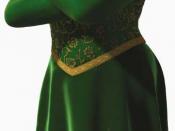The composer of "Shrek" has encouraged many morals such as 'Don't judge a book by its cover', 'Good always wins over the evil' and "No good deed always goes unrewarded'. The composer of Shrek uses film techniques to convey these morals. Film techniques such as lighting, music, camera angles, setting and costumes.
One of the most important morals the composer of Shrek encourages is 'Don't judge a book by its cover'. This means people cannot judge something or somebody simply by looking at their appearance.
The director has made "Shrek" look like an ugly and green ogre but he actually was a kind hearted ogre with feelings. This is shown when he was staring into Fiona's eyes and Fiona was staring into Shrek's eyes after he rescued her. The sunset was the background setting and they were shown in a close-up shot which shows emotions or romance. Another example would be when Shrek and Fiona were exchanging proclamations of love after Lord Farquaad was devoured by the dragon.
When Shrek kisses her, instead of turning back to human form, she turns permanently to an ogre. When Fiona says she was supposed to be beautiful, Shrek says she is already beautiful. Fiona and Shrek were shown in a close-up shot again showing romance. This ending stresses the relativity of beauty, thus leading the allegory to the moral.
The next moral shown was 'Good always wins over the evil'. The villain in Shrek was Lord Farquaad. The director used a range of film techniques to show the evil in Lord Farquaad. In the scene when Farquaad was preparing to torture the gingerbread man, there was loud organ music in the background with dark lighting which expresses dark and evil presence. Lord Farquaad himself is wearing red clothes which symbolises evil...


